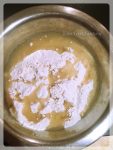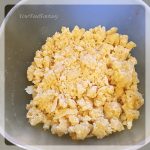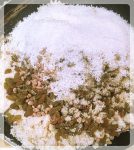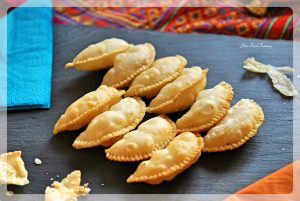Gujiya, what sort of image do you get in your mind, when you hear this word? I can’t stop thinking of palm sized deep fried tasty sweet dumplings. These small sweet delicacies, which are crisp and soft on top crust, and filled with yummy stuffing of mava, is a thing to die for. I take lot of pride in gujiyas I make, and I am hoping that my mava or khoya gujiya recipe is something which a gujiya lover will enjoy. Make these gujiyas during Holi (festival of colors), Diwali or any occasion, and these gujiyas won’t disappoint you.
Jump to :
What is Gujiya
Gujiya is a fried crispy pastry stuffed with sweet filling made from khoya, powdered sugar, dry fruits and desiccated coconut. Gujiya or gujia, is gift from India to the world.
Gujiyas are known by several names in different parts of India. In Gujarat they are known as Ghughra, Karanji in Maharastra, Kajikalayu in Andhra, Nevries in Goa, Karachika in Tamil Nadu, etc. Whilst the name and the stuffing used varies slightly across India, its charm is still the same across India.
As gujiya remains fresh for several days, you may prepare well in advance and have a relaxing festival. I still remember how my mum would start making gujiyas few days in advance of Holi. During those days in my life, cashews used to be a luxury for us, and my mum will strategically place one cashew in each gujiya. I would have so many stories to share related to gujiya, such as how my brother will quietly open the box and eat gujiya by stealing from kitchen and mum will scold both my brother and I, oh such joyful days of childhood!
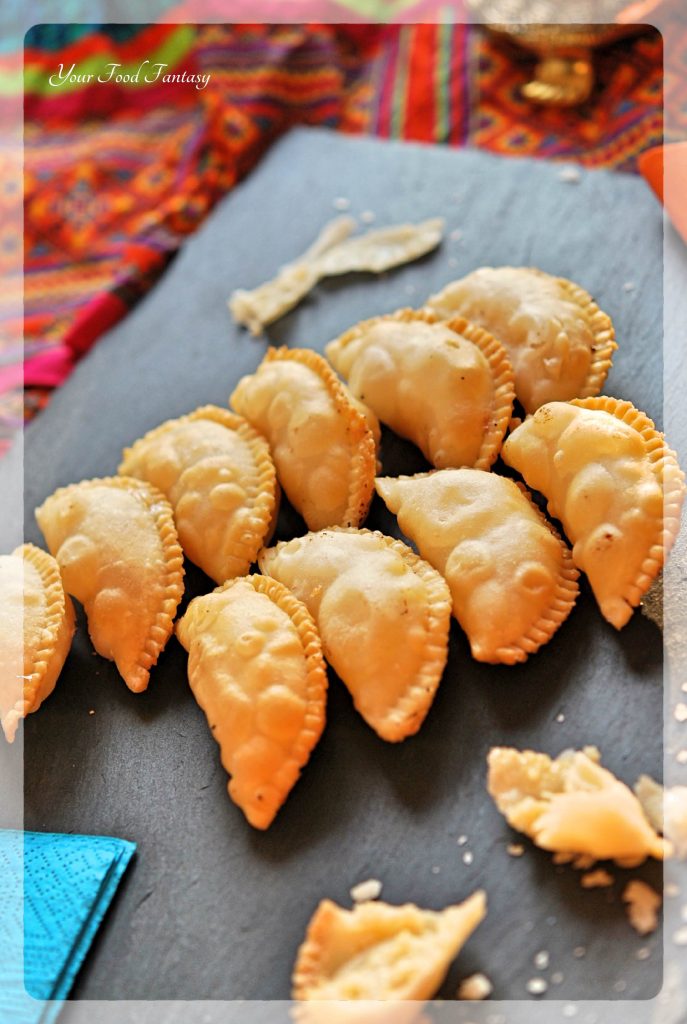
After my wedding and relocating to UK, I make gujiya every year on occasion of Holi. This gives me a feel of festival as well as my kids get chance to enjoy the tradition. Ever since I shared my gujiya with local friends, there has been a constant demand of gujiyas every festive season. With holi coming up next month, I am gearing to get my next batch of gujiyas ready. For those who are away and wish to try out making gujiya at home, can follow my recipe for one of the best gujiyas.
Ingredients
Gujiya has two parts. One is the outer crust and other is the stuffing.
- All purpose flour – You need all purpose flour aka maida for the crust or the dough of gujiya
- Ghee / Clarified butter – This acts as moyan in the flour. Normally the oil or ghee which is added in flour, prior to kneading the dough is called moyan (in northern part of India). Moyan is the key to dictate the level of crispiness, and softness of these gujiyas. Less or not balanced amount of moyan will lead to hard gujiyas.
- Mawa – I use mawa / mava aka Khoya, as stuffing in gujiya to give best taste.
- Makhana – I use Foxnut seeds too in the stuffing of gujiya. These are light weight and adds to the taste of gujiya and keeps them light weight and fluffy.
- Desiccated coconut, chirongee, and raisins – I use all these in the stuffing of gujiya. All these in correct proportion provides one of the yummiest stuffing.
- Sugar – Gujiya needs to be sweet. I use powdered sugar and add that to the stuffing. I keep sugar quantity just about optimum, high sugar will increase the probability of stuffing getting hard. No one would like hard stuffing, stuffing for gujiya needs to be soft as well as delicious.
Some people also use sooji / semolina in the stuffing, I do not do as I prefer using makhana over sooji. You can use other powdered nuts too in the stuffing in this khoya gujiya.

Method to make mava / khoya gujiya
A perfect gujiya is “light in weight, flaky on the surface and soft delicious stuffing“. These soft gujiya, won’t burst during frying. To achieve so, I have divided Gujiya making involves three steps.
To Make Pastry Or Dough For Gujiya
- Take all purpose flour / maida in a mixing bowl and sift it. After that, add ghee / clarified butter into it and mix well both the ingredients to make crumbles.
- Now add Luke warm water to flour and knead into a stiff dough just like we knead for poori. knead it for few more minutes as more we knead the dough, gujiya would be more crispier and tasty. Now cover the dough with damp cloth or kitchen towel and keep aside for 15 min.


Keeping gujiya dough moist | gujiya recipe at yourfoodfantasy
- In a bowl, take one tablespoon of flour and add few drops of water to make a paste which we will take help of for sealing the edges of gujiya.
To Make Stuffing For Gujiya
- In a Pan, dry roast 50 gram of lotus seeds / makhana for 5-7 minutes to make them crispy. Now switch off the flame and once cooled, transfer them into a grinding jar and grind them to make a fine powder.
- In the same pan take the khoya / mawa and roast it for about 2 min to make it soft. Once this cools, transfer it on to a mixing bowl and add rest of the ingredients for stuffing and mix well with the help of your hands avoiding any lumps, that’s your stuffing ready.
Steps for making soft gujiya
- Now it’s time to roll out gujiya, for this, take 1/2 tablespoon of the dough and make small round ball of it. Similarly, you can make few more balls and cover rest of dough with wet cloth again. Don’t make so many balls at a time otherwise they will dry up, making it difficult to roll.
- Place the circle on the gujiya mould and fill one tablespoon of the stuffing in centre. Now apply the flour paste on the edge of circle and close the mould to seal the sides properly.
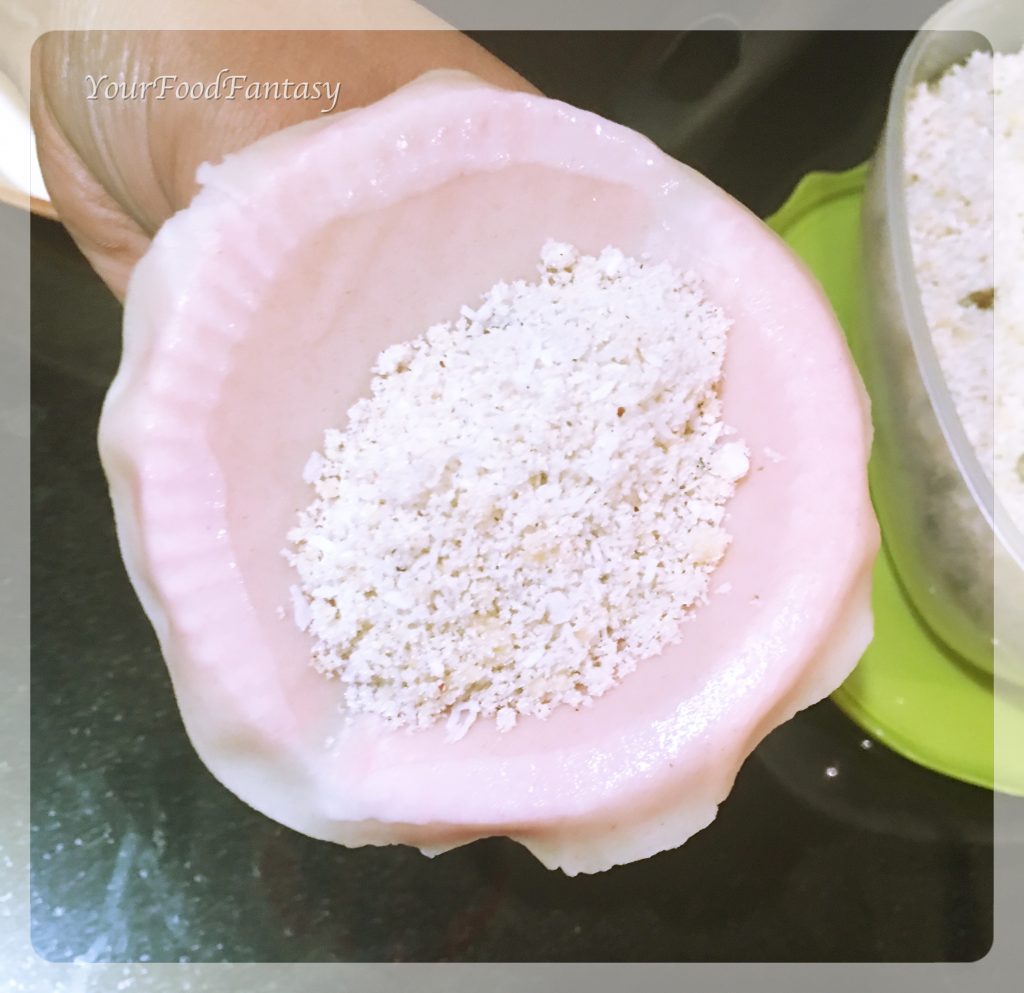
Filling gujiya using gujiya mould | gujiya recipe 
Gujiya using mould 
Gujiya made by mould
- In case you are not using mould then place the circle in your palm, fill the stuffing in centre, apply flour paste on edges and then gently close it and seal with the help of thumb impression. Now start twisting from one edge till the other to make a pleated impression. (Check Video below in recipe section).
- Now place them on a clean blanket and cover them with other bedsheets and similarly make rest of gujiya by repeating the above process.
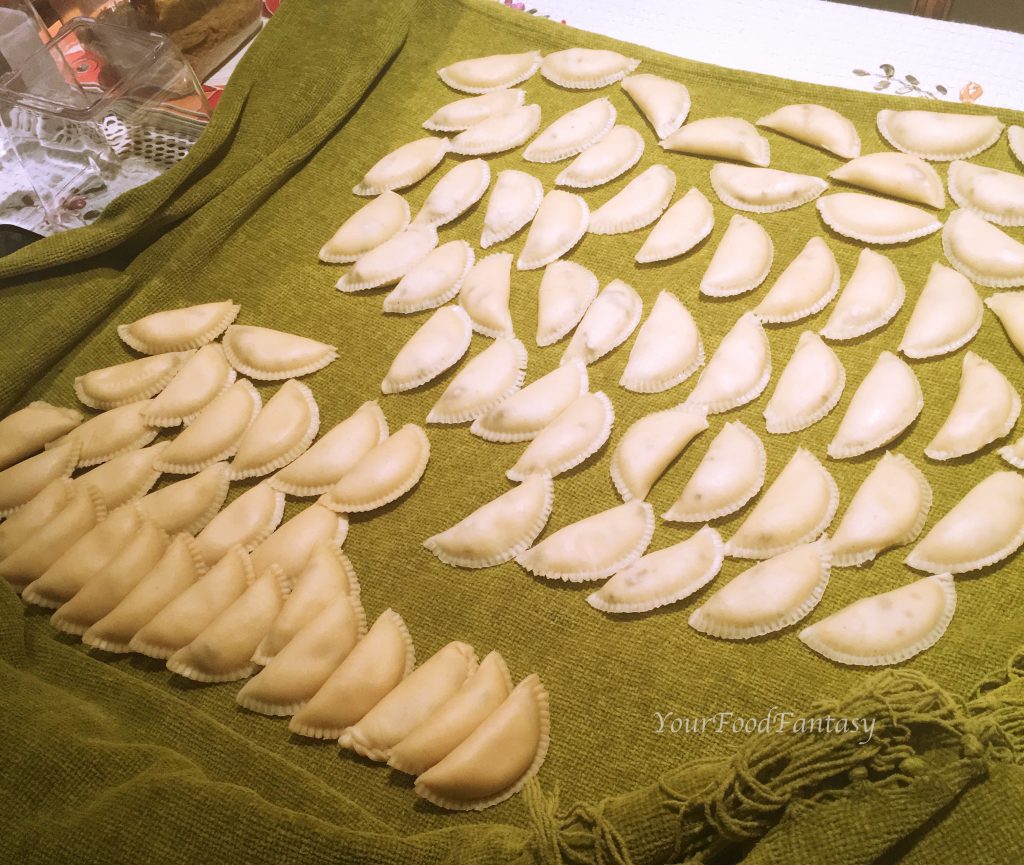
- Now heat oil in a pan/Kadhai and once hot, place 4-5 gujiya in it and fry them on low flame by turning them 3-4 times so that the outer crust is nice crisp. Once they become golden in colour take them out and place on kitchen towel.

- Once cooled to room temperature, store these soft gujiyas gently, in an airtight container.
Making gujiya by hand (without mould) vs mould
Traditional way of making gujiya involves pleates folded along the edges which is typical and time consuming. These folds are given so as to make sure the filling does not come out while frying. However, if you are unable to make pleates or running short of time, you can always use ready made gujiya mould to fold them. Personally I use mould to make gujiya, doing so all the gujiya get identical look. Also if you making hundreds of these gujiyas in a day, mould is very handy.
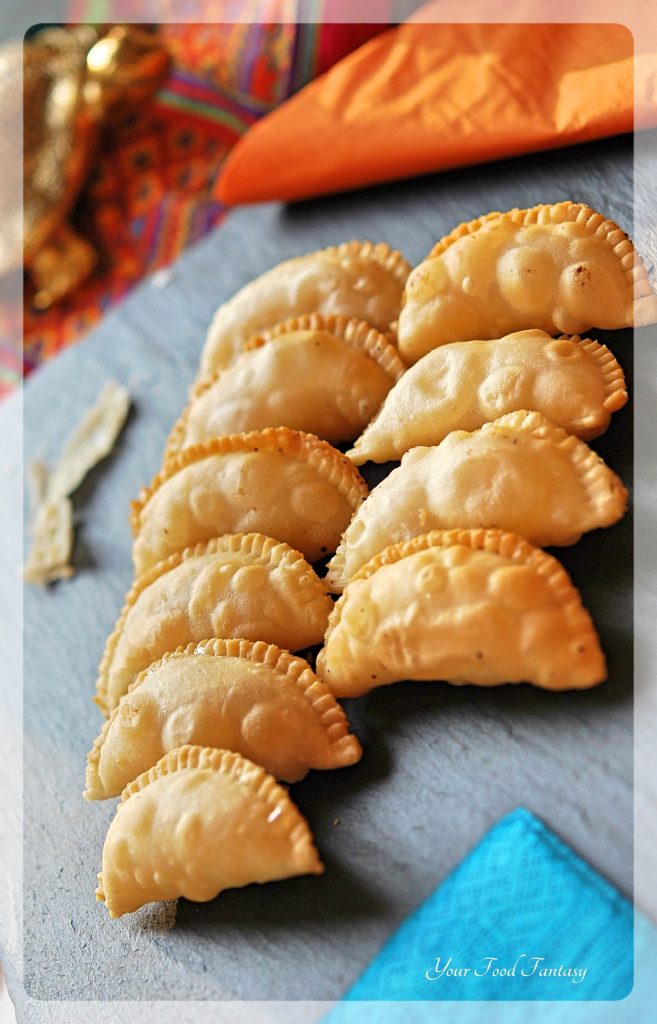
Pro Tips for best mava gujiya:
Kneading and getting the dough ready
- Use appropriate amount of moyan in kneading the dough for gujiya. As a thumb rule, when you hold dough in palm and close it, the dough should retain the shape, with out being sticky.
- Don’t add butter/ghee more than the mentioned quantity while kneading the dough, else the dough will become soft and gujiya can pop while frying.
- Try to knead the dough for at least 10 minutes as that will result in crispier gujiya.
- Do not break all the balls for gujiya dough from main dough at once, this will make the dough balls to dry up, whilst you get around to roll them. Make 2-3 dough balls at a time.
Stuffing
- You may have heard or experienced that gujiyas were hard or the stuffing in gujiya was hard, reason for this is that the dough was not given proper moyan. For the fluffy stuffing, use khoya / mawa along with makhana, try not to add sooji / semolina. Likewise, keep the sugar content to optimum amount. Too much sugar will make the stuffing hard.
- When making a huge batch of gujiya, try to use gujiya mould, it will give uniform shape to all gujiyas, as well as save effort and time.
- Before frying, likely you will get all the gujiyas ready, make sure that you keep them covered, else these will dry up and either break during frying or get blisters / bubbles while frying
- Do not exceed the quantity of stuffing in gujiya otherwise this may result in popping while frying.
- Gujiya making can be a cumbersome process, you can get the stuffing ready in advance to save time.
Frying
- You must fry these gujiyas on low to medium heat only, high heat will make these go dark in color as well as the risk would be there that these won’t be fried evenly. Low heat will give gujiya the desired crispy outer skin.
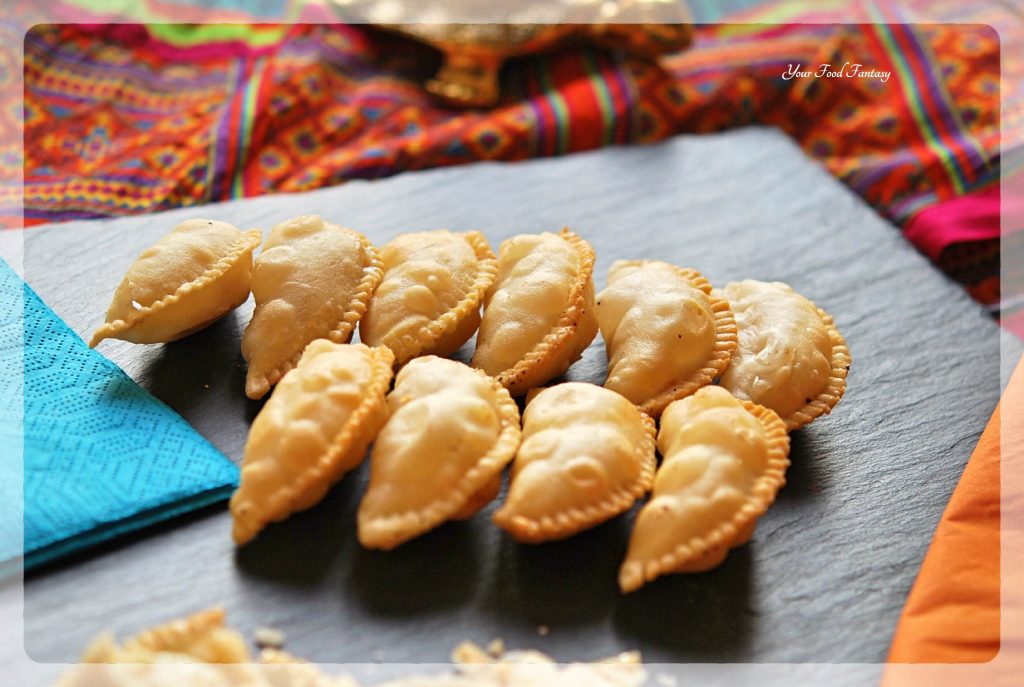
These mava gujiyas are
- Exceptionally tasty and nothing short of divine in taste
- So soft and crispy, that you won’t be able to stop at one, guaranteed!
- Have a good shelf life, and would last 2 weeks in an air tight box, which means you can make these in advance of the festival
- Not so complicated to make, if you plan ahead. Get the stuffing ready one day and then make gujiyas on another day. These gujiyas are worth the effort.
Other gujiya recipe versions
My this recipe of gujiya is using mava as stuffing, you can use other things in stuffing too, such as dry fruits, some have used fried dal / lentils too.
My recipe here is of deep fried gujiya, you can try to air fry or bake these gujiyas for healthier version of gujiya, however for me nothing beats this deep fried version. I call thesee gujiyas as “Holi special gujiya”
Storage and serving suggestion
Once gujiya gets cooled down to room temperature, store these in an air-tight container. These gujiyas in air-tight container will survive 2 weeks. Serve these as dessert or own its own as snack to your guests visiting you during the festive season.
Other festive recipes
If you looking for festive recipes, you may like to try
Recipe Card
Gujiya Recipe
Ingredients
For the pastry/dough for gujiya
- 2 Cups All Purpose Flour/ Maida
- 4 Tbsp Ghee / Clarified Butter
- 2/3 Cup Luke Warm Water To knead the dough
For Khoya / Mawa stuffing
- 250 Grams Mava / Khoya
- 4 Tbsp Foxnut / Lotus seeds / Makhanas
- 1 Cup Powdered Sugar
- 3 Tbsp Desiccated coconut
- 3 Tbsp Raisins
- 2 Tbsp Chironjee
- 1/4 Tsp Cardamom Powder
- 200 Ml Oil For deep frying
Instructions
To Make Pastry Or Dough For Gujiya
- Take all purpose flour/Maida in a mixing bowl and sift it. After that, add ghee/clarified butter into it and mix well both the ingredients to make crumbles.
- Now add Luke warm water to flour and knead into a stiff dough just like we knead for poori. knead it for few more minutes as more we knead the dough, gujiya would be more crispier and tasty.
- Now cover the dough with damp cloth or kitchen towel and keep aside for 15 min.
- In a bowl, take one tablespoon of flour and add few drops of water to make a paste which we will take help of for sealing the edges of gujiya.
To Make Stuffing For Gujiya:
- In a Pan, Dry roast 50 gram of lotus seeds/makhana for 5-7 minutes to make them crispy. Now switch off the flame and once cooled, transfer them into a grinding jar and grind them to make a fine powder.
- In the same pan take the khoya/mawa and roast it for about 2 min to make it soft. Once this cools, transfer it on to a mixing bowl and add rest of the ingredients for stuffing and mix well with the help of your hands avoiding any lumps. Your stuffing is now ready to be filled into the gujiyas.
Steps for making Gujiya
- Now it’s time to roll out gujiya. Take 1/2 tablespoon of the dough and make small round ball of it. Similarly you can make few more balls and cover rest of dough with wet cloth again. Don’t make so many balls at a time otherwise they will be dried resulting in difficulty to roll.
- Now with the help of the rolling pin roll it to a thin circle of approx 3-4 inch in diameter.
- Place the circle on the gujiya mould and fill one tablespoon of the stuffing in centre. Now apply the flour paste on the edge of circle and close the mould to seal the sides properly.
- In case you are not using mould then place the circle in your palm, fill the stuffing in centre, apply flour paste on edges and then gently close it and seal with the help of thumb impression. Now start twisting from one edge till the other to make a pleated impression.
- Now place them on a clean bedsheets or blanket and cover them with other bedsheets and similarly make rest of gujiya by repeating the above process. This will help them not to dry.
- Now heat oil in a pan/Kadhai and once hot, place 4-5 gujiya in it and fry them on low flame by turning them 3-4 times so that the outer crust is nice crisp. Once they become golden in colour take them out and place on kitchen towel.
- Once cooled to room temperature, store these soft gujiyas gently, in an airtight container.
Notes
- You can use semolina/rava/sooji instead of powdered lotus seeds in the stuffing. For that just roast the same quantity of rava/sooji as of powdered lotus seeds, till its golden brown and add into the stuffing once its cooled. I don’t use semolina so I replace it with powdered lotus seeds.
- Don’t add butter/ghee more than the mentioned quantity while kneading the dough, else the dough will become soft and gujiya can pop while frying.
- Do not exceed the quantity of stuffing in gujiya otherwise thismay result in popping while frying.
- Try to knead the dough for at least 10 minutes as that will result in crispier gujiya.
- Always fry gujiyas on low to medium flame so that the outer layer becomes crisp.
